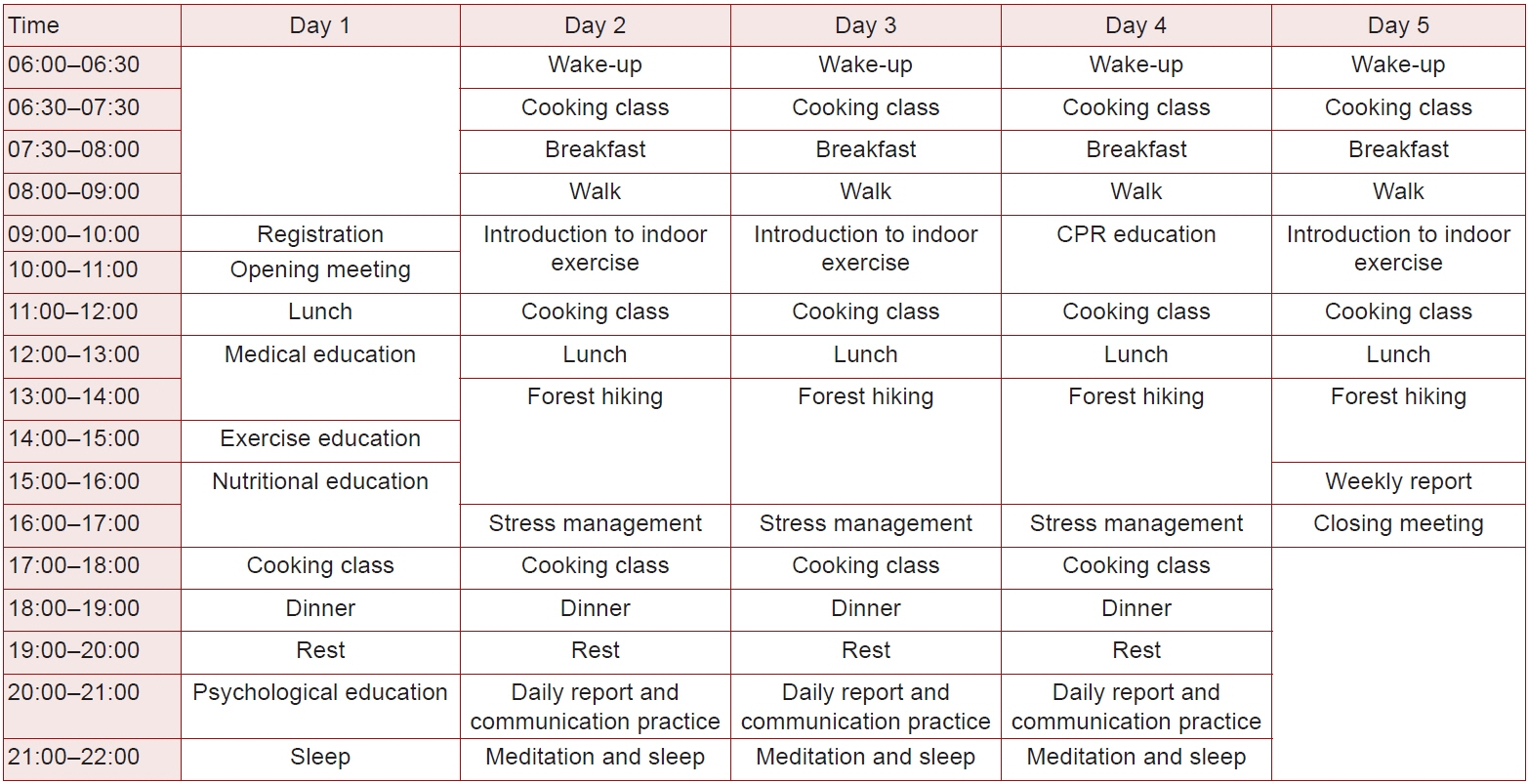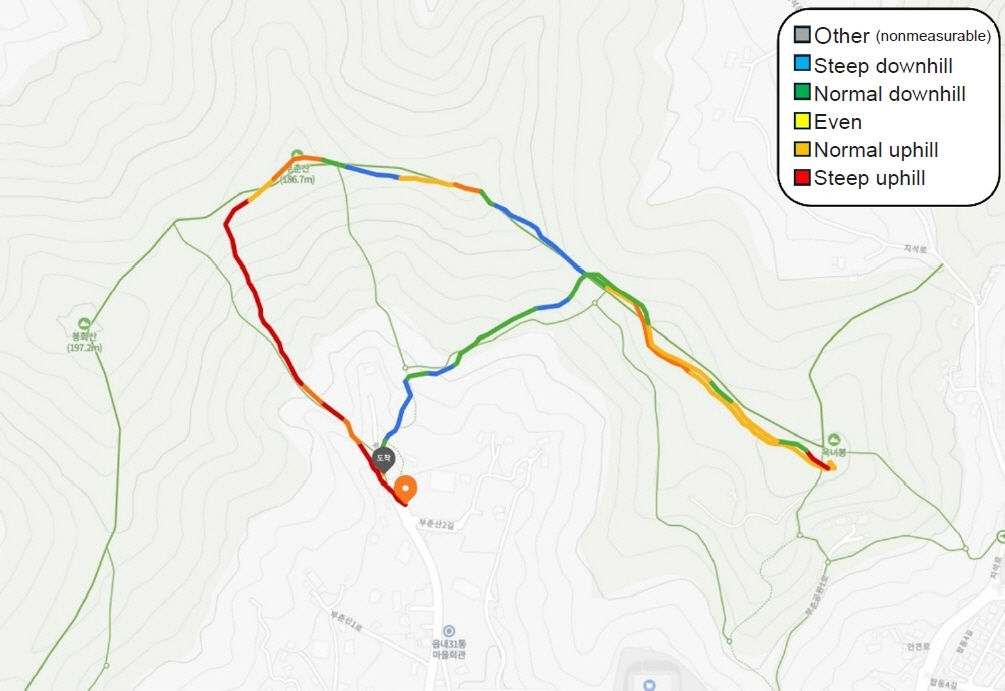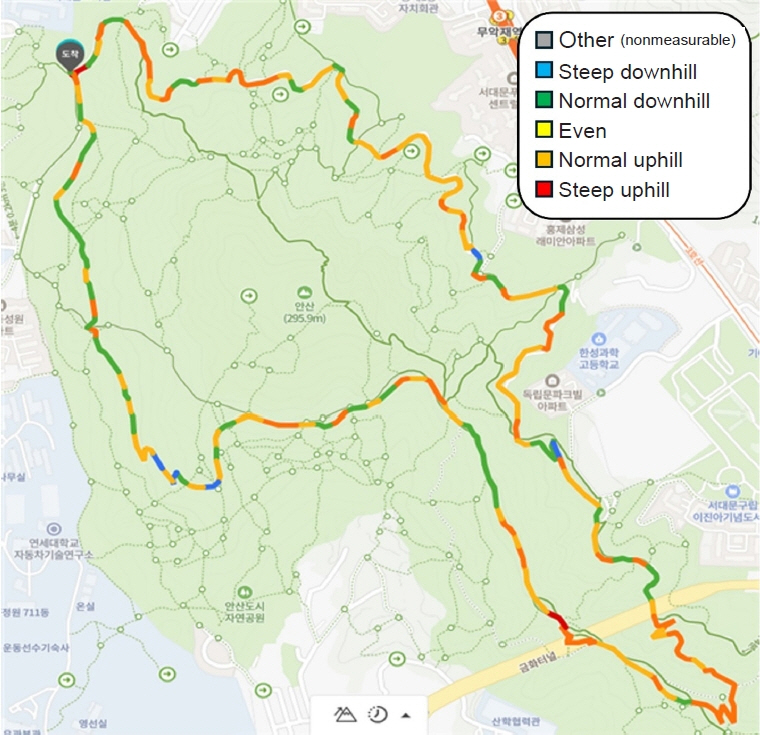Cardiovasc Prev Pharmacother.
2024 Apr;6(2):74-83. 10.36011/cpp.2024.6.e10.
Cardiac rehabilitation using intensive lifestyle habituation combined with outdoor exercise in an urban forest environment for primary and secondary prevention of coronary artery disease: a feasibility test
- Affiliations
-
- 1Division of Cardiology, Department of Internal Medicine, Kangbuk Samsung Hospital, Seoul, Korea
- 2Wellness Academy, Seoul, Korea
- 3Department of Physical Education, Social Culture Graduate School, Jungwon University, Goesan, Korea
- 4ACE Exercise Science Center, Seosan, Chungnam, Korea
- KMID: 2554784
- DOI: http://doi.org/10.36011/cpp.2024.6.e10
Abstract
- Background
We aimed to examine the feasibility of intensive lifestyle habituation with a subsequent home program, including forest-based exercise, as an alternative approach to conventional cardiac rehabilitation for both primary and secondary prevention of coronary artery disease (CAD).
Methods
A total of 28 participants were included in a 1-week intensive education program aimed at fostering desirable lifestyle habits in the study: 17 patients who underwent percutaneous coronary intervention and 11 participants at high risk of CAD. Subsequently, they engaged in a self-directed, home-based program that included unstructured exercise in an urban forest. The terrain of the urban forest was analyzed to estimate metabolic equivalent levels and to assess safety and accessibility for patient exercise.
Results
Throughout the program, no adverse cardiac events were reported. Additionally, risk factors for CAD—including body composition, blood sugar levels, hemodynamic variables, total cholesterol levels, and cardiorespiratory endurance—showed significant improvement in both groups.
Conclusions
Intensive lifestyle habituation and unstructured, self-directed exercise in the forest were as effective and safe as conventional cardiac rehabilitation for patients with CAD. The study demonstrated that an urban forest could serve as a safe exercise environment in both primary and secondary prevention strategies for CAD.
Figure
Reference
-
1. McMahon SR, Ades PA, Thompson PD. The role of cardiac rehabilitation in patients with heart disease. Trends Cardiovasc Med. 2017; 27:420–5.
Article2. Salzwedel A, Jensen K, Rauch B, Doherty P, Metzendorf MI, Hackbusch M, et al. Effectiveness of comprehensive cardiac rehabilitation in coronary artery disease patients treated according to contemporary evidence based medicine: update of the Cardiac Rehabilitation Outcome Study (CROS-II). Eur J Prev Cardiol. 2020; 27:1756–74.
Article3. Li Q, Morimoto K, Kobayashi M, Inagaki H, Katsumata M, Hirata Y, et al. Visiting a forest, but not a city, increases human natural killer activity and expression of anti-cancer proteins. Int J Immunopathol Pharmacol. 2008; 21:117–27.
Article4. Servey JT, Stephens M. Cardiac rehabilitation: improving function and reducing risk. Am Fam Physician. 2016; 94:37–43.5. Balady GJ, Williams MA, Ades PA, Bittner V, Comoss P, Foody JM, et al. Core components of cardiac rehabilitation/secondary prevention programs: 2007 update: a scientific statement from the American Heart Association Exercise, Cardiac Rehabilitation, and Prevention Committee, the Council on Clinical Cardiology; the Councils on Cardiovascular Nursing, Epidemiology and Prevention, and Nutrition, Physical Activity, and Metabolism; and the American Association of Cardiovascular and Pulmonary Rehabilitation. Circulation. 2007; 115:2675–82.
Article6. Smith SC Jr, Allen J, Blair SN, Bonow RO, Brass LM, Fonarow GC, et al. AHA/ACC guidelines for secondary prevention for patients with coronary and other atherosclerotic vascular disease: 2006 update: endorsed by the National Heart, Lung, and Blood Institute. Circulation. 2006; 113:2363–72.
Article7. Balady GJ, Ades PA, Bittner VA, Franklin BA, Gordon NF, Thomas RJ, et al. Referral, enrollment, and delivery of cardiac rehabilitation/secondary prevention programs at clinical centers and beyond: a presidential advisory from the American Heart Association. Circulation. 2011; 124:2951–60.
Article8. Swiątkiewicz I, Di Somma S, De Fazio L, Mazzilli V, Taub PR. Effectiveness of intensive cardiac rehabilitation in high-risk patients with cardiovascular disease in real-world practice. Nutrients. 2021; 13:3883.
Article9. Yoo RH, Jeong SA. A case study on application of the effect using forest on human health improvement and disease prevention: focusing on the forest therapy certification in Japan. J Korean Inst For Recreat. 2009; 13:45–51.10. Lee JH, Renate BA. Understanding the healing function of urban forests in German cities. J Korean Inst For Recreat. 2011; 15:81–9.
Article11. Kim SC, Han YH, Park KU, Oh HK. Improvement methods of the forest therapeutic function in recreational forest. J Korean Inst For Recreat. 2008; 12:1–8.12. Cho YM, Shin WS, Yeoun PS, Lee HE. The influence of forest experience program on children from low income families, sociality and depression. J Korean Inst For Recreat. 2011; 15:69–75.
Article13. Park BJ. Experimental approach of therapeutic effect of forest recreation activities: focused on viewing and walking in forest environments [dissertation]. Chungnam National University; 2010.14. Kim G. Relationship between seasonal NVOC concentration and physical environment in Pinus densiflora forest [master’s thesis]. Chungnam National University; 2014.15. Lee JH, Shin WS, Yeoun PS, Yoo RH. The influence of forest scenes on psychophysiological responses. J Korean Soc For Sci. 2009; 98:88–93.16. Looney DP, Santee WR, Hansen EO, Bonventre PJ, Chalmers CR, Potter AW. Estimating energy expenditure during level, uphill, and downhill walking. Med Sci Sports Exerc. 2019; 51:1954–60.
Article17. American College of Sports Medicine (ACSM). ACSM's guidelines for exercise testing and prescription. 10th ed. Wolters Kluwer; 2017.18. Jang S. The effect of aerobic and resistance exercise on serum apelin concentration and risk factors of metabolic syndrome in middle aged obese women [master’s thesis]. Yonsei University; 2016.19. Kim S. The effects of carbohydrate mouth rinse on epinephrine concentration and exercise performance in obese middle-aged women during exercise [master’s thesis]. Yonsei University; 2022.20. Noh SG, Paik IY. The effects of different intensive aerobic training on serum omentin-1 concentration and cardiovascular risk factors in middle-aged obese women. J Sport Leis Stud. 2015; 62:841–51.
Article21. Kim CJ, Kim HW. Effects of an 8 weeks walking exercise on blood lipid and HbA1c in obese old women. Korean J Sport. 2017; 15:609–16.22. Tran ZV, Weltman A, Glass GV, Mood DP. The effects of exercise on blood lipids and lipoproteins: a meta-analysis of studies. Med Sci Sports Exerc. 1983; 15:393–402.23. Um HG, Lee SH, Choi CS, Kim TY. The effect of mountain climbing on blood lipid profiles, MDA and SOD in middle aged men. Korean J Sport Sci. 2010; 19:795–805.24. Jeon YJ. The effects of aerobic exercise on the improvement of cardiovascular disease in elderly metabolic syndrome women. Korean J Sport. 2018; 16:653–8.25. Kim CH, Lee H. Effects of aerobic exercise duration on body composition, serum density of lipid, diet and metabolic regulation hormone in middle aged obese women. Exerc Sci. 2014; 23:193–203.
Article26. Thompson PD, Yurgalevitch SM, Flynn MM, Zmuda JM, Spannaus-Martin D, Saritelli A, et al. Effect of prolonged exercise training without weight loss on high-density lipoprotein metabolism in overweight men. Metabolism. 1997; 46:217–23.
Article27. Williams PT. Relationship of distance run per week to coronary heart disease risk factors in 8283 male runners: the National Runners’ Health Study. Arch Intern Med. 1997; 157:191–8.
Article28. Ridker PM, Rane M. Interleukin-6 signaling and anti-interleukin-6 therapeutics in cardiovascular disease. Circ Res. 2021; 128:1728–46.
Article29. Li Y, Zhong X, Cheng G, Zhao C, Zhang L, Hong Y, et al. Hs-CRP and all-cause, cardiovascular, and cancer mortality risk: a meta-analysis. Atherosclerosis. 2017; 259:75–82.
Article30. Zhao H, He Z, Yun H, Wang R, Liu C. A meta-analysis of the effects of different exercise modes on inflammatory response in the elderly. Int J Environ Res Public Health. 2022; 19:10451.
Article31. Koh SH, Kim DY, Kang DW, Kim TK, Ha SM. Effect of free weight exercise on IL-6, hs-CRP and IL-10 in elderly women. J Korean Assoc Phys Educ Sport Girls Women. 2022; 36:99–112.
Article32. Koh SH, Kim TK, Son SY, Kim MK, Kim DY. Effect of combined exercise on serum lipids, liver function and inflammatory levels of hs-CRP on elderly women. J Korean Assoc Phys Educ Sport Girls Women. 2023; 37:179–93.
Article33. Kandelouei T, Abbasifard M, Imani D, Aslani S, Razi B, Fasihi M, et al. Effect of statins on serum level of hs-CRP and CRP in patients with cardiovascular diseases: a systematic review and meta-analysis of randomized controlled trials. Mediators Inflamm. 2022; 2022:8732360.
Article34. Myers J, McAuley P, Lavie CJ, Despres JP, Arena R, Kokkinos P. Physical activity and cardiorespiratory fitness as major markers of cardiovascular risk: their independent and interwoven importance to health status. Prog Cardiovasc Dis. 2015; 57:306–14.
Article35. Ross R, Blair SN, Arena R, Church TS, Despres JP, Franklin BA, et al. Importance of assessing cardiorespiratory fitness in clinical practice: a case for fitness as a clinical vital sign: a scientific statement from the American Heart Association. Circulation. 2016; 134:e653–99.
Article36. Lavie CJ, Thomas RJ, Squires RW, Allison TG, Milani RV. Exercise training and cardiac rehabilitation in primary and secondary prevention of coronary heart disease. Mayo Clin Proc. 2009; 84:373–83.
Article37. Myers J, Prakash M, Froelicher V, Do D, Partington S, Atwood JE. Exercise capacity and mortality among men referred for exercise testing. N Engl J Med. 2002; 346:793–801.
Article38. Kavanagh T, Mertens DJ, Hamm LF, Beyene J, Kennedy J, Corey P, et al. Peak oxygen intake and cardiac mortality in women referred for cardiac rehabilitation. J Am Coll Cardiol. 2003; 42:2139–43.
Article39. Roger VL, Jacobsen SJ, Pellikka PA, Miller TD, Bailey KR, Gersh BJ. Prognostic value of treadmill exercise testing: a population-based study in Olmsted County, Minnesota. Circulation. 1998; 98:2836–41.40. Lewis SF, Nylander E, Gad P, Areskog NH. Non-autonomic component in bradycardia of endurance trained men at rest and during exercise. Acta Physiol Scand. 1980; 109:297–305.
Article41. Levy WC, Cerqueira MD, Harp GD, Johannessen KA, Abrass IB, Schwartz RS, et al. Effect of endurance exercise training on heart rate variability at rest in healthy young and older men. Am J Cardiol. 1998; 82:1236–41.
Article42. Stein PK, Ehsani AA, Domitrovich PP, Kleiger RE, Rottman JN. Effect of exercise training on heart rate variability in healthy older adults. Am Heart J. 1999; 138(3 Pt 1):567–76.
Article43. Goldsmith RL. A comparison of parasympathetic activity in endurance trained and untrained men [dissertation]. Teachers College, Columbia University; 1991.
- Full Text Links
- Actions
-
Cited
- CITED
-
- Close
- Share
- Similar articles
-
- The Effect of a Self Exercise Program in Cardiac Rehabilitation for Patients with Coronary Artery Disease
- Cardiac Rehabilitation in Patients with Coronary Artery Disease
- Cardiac rehabilitation for patients with coronary artery disease
- Epidemiological Characteristics of Scrub Typhus in Korea, 2009
- Effectiveness of the Cardiac Rehabilitation on Exercise Capacity and Risk Factor in Coronary Artery Obstructive Disease




